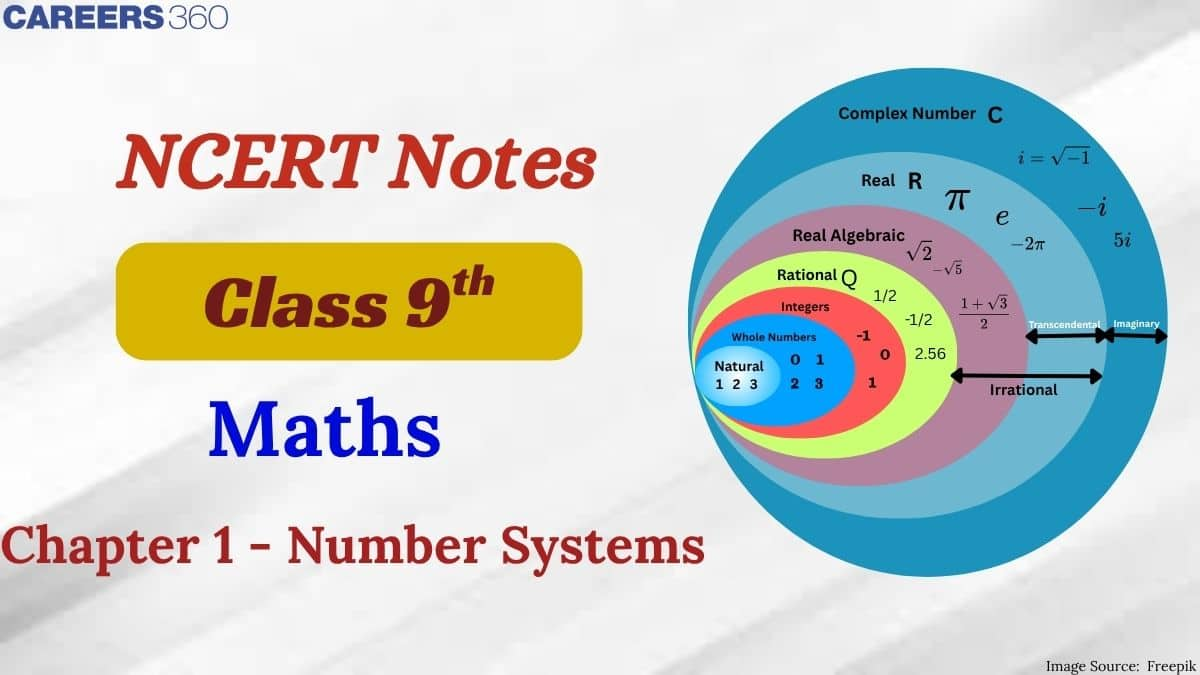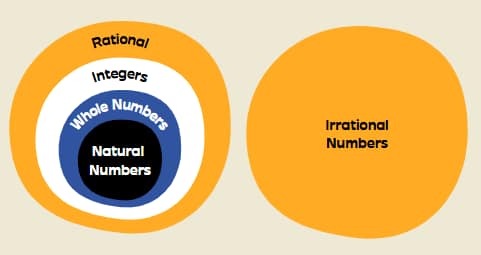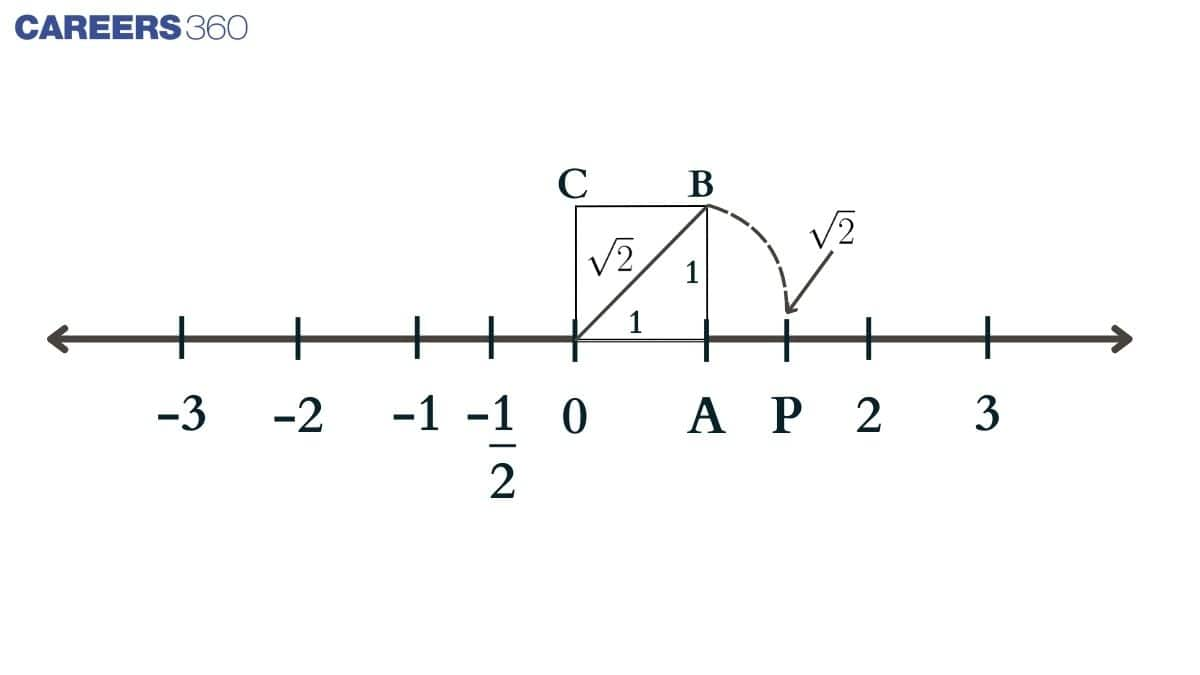NCERT Class 9 Maths Chapter 1 Notes – Number System (PDF Download)
Mathematics requires numbers as essential elements to symbolise everyday quantities, together with measurements and values. Different number types receive status classification within the number system through their inherent properties. The exploration in this chapter covers the classification of numbers, including natural numbers, whole numbers, integers, rational numbers, and irrational numbers. The different number classifications enable us to carry out mathematical processes effectively when solving real-world problems. Students must practice all the topics of the Number System to score better. Along with this, the NCERT Class 9 Maths notes present detailed information about mathematical principles.
This Story also Contains
- Class 9 Number Systems Notes PDF – Download Free Study Material
- NCERT Notes Class 9 Maths Chapter 1 Number Systems
- How to Use the Number Systems Class 9 Notes Effectively?
- Number Systems Class 9 Notes: Previous year Question and answer
- NCERT Class 9 Maths Notes – Chapter-Wise Links

Number systems is a very important chapter not only in class 9 but also for future classes. So understanding these concepts thoroughly is a plus point for students. The primary benefit of NCERT notes is that they present concepts clearly and straightforwardly, making learning easier and more effective. These notes are trustworthy and reliable, as they are created by subject matter experts at Careers360, making them an essential resource for exam preparation. Check this NCERT article for complete syllabus coverage along with NCERT Books, Solutions, Syllabus, and Exemplar Problems with Solutions.
Also, read,
Class 9 Number Systems Notes PDF – Download Free Study Material
Careers360 brings you NCERT Class 9 Maths Chapter 1 Number Systems notes, carefully prepared by subject experts to simplify your studies and help in exams. A downloadable PDF is available — click the link below to access it.
NCERT Notes Class 9 Maths Chapter 1 Number Systems
A number is a mathematical entity used for counting, measuring, and labelling. Mathematical operations of addition, subtraction, multiplication and division work with the help of numbers. Numbers exist in multiple categories according to their nature, featuring natural numbers, whole numbers, integers, rational numbers and irrational numbers.

Natural numbers
These are the numbers that start from the count of one to infinity. The natural numbers can be represented by “N”. Natural numbers are always positive. Multiplication and addition operations between natural numbers produce only natural numbers as results.
Example of Natural Numbers: N = {1, 2, 3, 4, 5, 6……}
Whole numbers
These include all natural numbers but start from the count of zero. The whole numbers can be represented by “W”. All natural numbers are whole numbers, except 0, which is not a natural number but is a whole number.
Example of Whole Numbers: W = { 0, 1, 2, 3, 4, 5, 6, …}
Integers
These are the numbers that include both positive and negative numbers, along with zero. Although Zero is an integer, it exists outside the boundaries of positive and negative numbers, which means it is neither positive nor negative.
Example of Integers: {…-5, -4, -3, -2, -1, 0, 1, 2, 3, 4, 5……}
Rational numbers
These are the numbers that are any real number and can be expressed in the form $\frac{p}{q}$ of R where the denominator $q ≠ 0$. It is represented by "Q". It is noted that every integer number is a rational number. The decimal expansion of these numbers is either repeating or terminating.
Example of Rational Numbers: $\frac{1}{2}$, $\frac{3}{4}$, $\frac{-7}{8}$, $0.3333...$, etc.
On division of $p$ by $q$, two main things happen – either the remainder becomes zero or never becomes zero, and we get a repeating string of remainders.
Case (i): The Remainder Becomes Zero
This is the case of terminating numbers, which means that after dividing the numbers, the remainder comes as 0.
Example: $\frac{7}{8}$ = 0.875
When the numbers are divided, the remainder is 0. And therefore called a terminating number.
Case (ii): The Remainder Never Becomes Zero
This is the case of repeating numbers, which means the remainders repeat after a certain stage, forcing the decimal expansion to go on forever.
Example: $\frac{10}{3}$ = 3.3333….
When the numbers are divided, we have a repeating block of digits in the quotient, and the remainders are not equal to zero.
How to Find a Rational Number Between Two Numbers?
The calculation of an average between two numbers $a$ and $b$ produces a rational number. It means:
Rational number = $\frac{\text{a + b}}{2}$
Example: Find a rational number between 1 and 2.
Solution: According to the formula, take the average of the numbers:
Rational Number = $\frac{1 + 2}{2} = \frac{3}{2} $
To find another rational number, repeat the same process; hence, it means that there are infinitely many rational numbers between any two given rational numbers.
Irrational Numbers
These are the numbers that cannot be expressed in the form $\frac{p}{q}$ of R where the denominator $q ≠ 0$. The decimal expansion of these numbers is non-repeating and non-terminating. Like rational numbers, there are infinitely many irrational numbers, too.
Example of Irrational Numbers: $√2$,$√3$, $π$, $0.34343...$, etc.
Real Numbers
These numbers are defined as those that can be represented on the number line. They are further divided into two parts such as rational and irrational numbers. They can be represented as $R$.
Note: Each real number finds its distinct position as a point along the number line. Furthermore, the number line contains unique real numbers at every one of its points.
Representation of Real Numbers on the Number Line
The number line provides a visual representation scheme that displays both rational and irrational numbers among the real numbers. The number line serves to demonstrate how numbers are positioned relative to each other.
Steps to Plot an Irrational Number on a Number Line
- Construct a horizontal line which uses zero as its base point.
- Put the negative numbers on the left and the positive ones on the right.
- Locate the two square numbers that contain the provided irrational number.
- Construct a right-angled triangle using Pythagoras' theorem to represent the given irrational number through the hypotenuse.
- Measure the hypotenuse of the triangle with a compass.
- Set your compass pointer to 0 on the number line, then draw a mark at the measured distance.
- The necessary irrational number is indicated by the marked point on the number line.
- Label it accordingly.
Example: Locate √2 on the number line.
Solution: Steps to solve the problem:
- Draw a horizontal number line.
- Mark the integers -3, -2, -1, 0, 1, 2, 3, etc., keeping equal spacing between them.
- √2 must lines between 1 and 2.
- At 1, draw a perpendicular line of 1 unit upwards.
- Join the new point to 0 to form a right-angled triangle having base and height equal to 1.
- Since a right-angled triangle is formed, check the hypotenuse with Pythagoras' theorem.
- Take a compass and set its length to the hypotenuse of the triangle.
- Place the compass pointer at 0 and draw an arc on the number line.
- The intersection of the arc and the number line gives the required point of √2.

Key Points
(i) The sum or difference of a rational number and an irrational number is irrational.
(ii) The product or quotient of a non-zero rational number with an irrational number is irrational.
(iii) If we add, subtract, multiply or divide two irrationals, the result may be rational or Irrational.
Identities Related to Square Roots
The fundamental identities of square roots enable both the simplification of expressions and the solution of equations. Several important identities exist for square roots, which are as follows:
- $\sqrt{ab} = \sqrt{a} \times \sqrt{b}$
- $\sqrt{\frac{a}{b}} = \frac{\sqrt{a}}{\sqrt{b}}$
- $(\sqrt{a} + \sqrt{b})(\sqrt{a} - \sqrt{b}) = a - b$
- $( a + \sqrt{b})( a - \sqrt{b}) = a^2 - b$
- $(\sqrt{a} + \sqrt{b})(\sqrt{c} + \sqrt{d}) = \sqrt{ac} + \sqrt{ad} + \sqrt{bc} + \sqrt{bd} $
- $(\sqrt{a} + \sqrt{b})^2 = a + 2\sqrt{ab} + b$
Rationalising the Denominator
Converting an expression containing irrational denominators into equivalent fractions with rational denominators represents the process of denominator rationalisation. To achieve rationalisation, we apply multiplication on both the numerator and denominator by an acceptable conjugate or irrational factor until the square root disappears.
Example: Rationalize $\frac{1}{\sqrt{5}}$
Solution: $\frac{1}{\sqrt{5}} \times \frac{\sqrt{5}}{\sqrt{5}} = \frac{\sqrt{5}}{5}$
$\frac{2}{3+\sqrt{2}} \times \frac{3-\sqrt{2}}{3-\sqrt{2}} = \frac{6 - 2\sqrt{2}}{7}$
Laws of Exponents for Real Numbers
When a number is multiplied repeatedly, it is represented by an exponent, also known as a power. For real numbers, the exponent laws listed below are applicable:
- $a^m \times a^n = a^{m+n}$
- $\frac{a^m}{a^n} = a^{m-n}, \quad a \neq 0 $
- $(a^m)^n = a^{m \times n}$
- $a^m \times b^m = (a \times b)^m$
1. Let a > 0 be a real number. Let m and n be integers such that m and n have no common factors other than 1, and n > 0.
Then,
$a^{\frac{m}{n}} = \sqrt[n]{a^m} = \left( \sqrt[n]{a} \right)^m$
2. Let a > 0 be a real number and n a positive integer. Then,
$\sqrt[n]{a} = b$ if $b^n = a$ and b > 0
$\sqrt[n]{a} = a^\frac{1}{n}$
How to Use the Number Systems Class 9 Notes Effectively?
Using the Number Systems notes effectively makes this chapter much easier to understand. It also helps you build a strong base for future maths topics. When revising, ensure you stay focused on the main ideas from the chapter. NCERT Class 9 Maths Chapter 1 notes are the best way to do that. Here are some additional points on how to use these notes efficiently.
- Read topics such as irrational numbers, decimal expansions, and exponents slowly and try to understand the examples before attempting to solve questions.
- Make short summaries of rules, such as operations on real numbers and laws of exponents, so that you can revise them quickly anytime.
- Keep checking the NCERT Class 9 Maths chapter 1 notes while solving textbook questions, as these notes help us avoid mistakes and strengthen our basics.
- A strong understanding of the NCERT Class 9 Maths Chapter 1 notes will help us a lot in higher classes, especially in real numbers and algebra topics.
Number Systems Class 9 Notes: Previous year Question and answer
Listed below are important previous year question answers for NCERT Class 9 Maths Chapter 1 Number Systems compiled from different board exams.
Question 1:
The product of two consecutive prime numbers is 7387. What is the difference between the two numbers?
Solution:
The product of two consecutive prime numbers = 7387
$86^2=7396$ is closest to 7387.
So, the prime numbers close to 86 are 83 and 89, which are consecutive.
7387 = 83 × 89
$\therefore$ Difference = 89 – 83 = 6
Hence, the correct answer is 6.
Question 2:
What is the value of $\frac{8 \times 5 \div 25}{7 \div 14 \times 2}-\frac{14 \div 7-5}{7 \div 14-25} ?$
Solution:
$\frac{8 \times 5 \div 25}{7 \div 14 \times 2}-\frac{14 \div 7-5}{7 \div 14-25} $
$=\frac{\frac{8}{5}}{1}-\frac{2-5}{\frac{1}{2}-25} $
$=\frac{8}{5}-\frac{-3}{-\frac{49}{2}} $
$=\frac{8}{5}-\frac{6}{49}$
$=\frac{392-30}{245}$
$=\frac{362}{245}$
Hence, the correct answer is $\frac{362}{245}$.
Question 3:
If the sum of a number and its reciprocal is 4, find the sum of their squares.
Solution:
Let the number be $x$.
Reciprocal = $\frac{1}{x}$
According to the question,
$x + \frac{1}{x} = 4$
Squaring both sides, we get:
⇒ $(x + \frac{1}{x})^2 = 4^2$
⇒ $x^2+ \frac{1}{x^2}+2 = 16$
⇒ $x^2 + \frac{1}{x^2} = 16 - 2 = 14$
Hence, the correct answer is 14.
NCERT Class 9 Maths Notes – Chapter-Wise Links
For the convenience of students, Careers360 provides complete NCERT Class 9 Maths notes together in one location. Simply click the links below to access.
|
NCERT Notes Class 9 Maths Chapter 1 Number Systems |
|
NCERT Notes Class 9 Maths Chapter 4 Linear Equation in Two Variables |
|
NCERT Notes Class 9 Maths Chapter 5 Introduction To Euclid’s Geometry |
|
NCERT Notes Class 9 Maths Chapter 11 Surface Areas and Volumes |
NCERT Solutions for Class 9
Students must check the NCERT solutions for Class 9 Maths and Science given below:
NCERT Exemplar Solutions for Class 9
Students must check the NCERT exemplar solutions for Class 9 Maths and Science given below:
NCERT Books and Syllabus
Before the start of a new academic year, students should refer to the latest syllabus to determine the chapters they’ll be studying. Below are the updated syllabus links, along with some recommended reference books.
Frequently Asked Questions (FAQs)
The number system includes Natural Numbers (N), Whole Numbers (W), Integers (Z), Rational Numbers (Q), Irrational Numbers, and Real Numbers (R).
Yes, every integer can be written in the form p/1, so all integers are rational numbers.
Real numbers follow properties such as closure, commutativity, associative, distributive, identity, and inverse properties.
Yes, the Number Systems Class 9 Notes strictly follow the latest NCERT syllabus and CBSE exam guidelines.
Many educational platforms, such as Careers360, offer free downloadable PDFs of Number Systems Class 9 Notes. Students can find the free downloadable PDF in this article itself.
Courses After 12th
Applications for Admissions are open.
As per latest syllabus. Physics formulas, equations, & laws of class 11 & 12th chapters
JEE Main Important Chemistry formulas
Get nowAs per latest syllabus. Chemistry formulas, equations, & laws of class 11 & 12th chapters
JEE Main high scoring chapters and topics
Get nowAs per latest 2024 syllabus. Study 40% syllabus and score upto 100% marks in JEE
JEE Main Important Mathematics Formulas
Get nowAs per latest syllabus. Maths formulas, equations, & theorems of class 11 & 12th chapters
